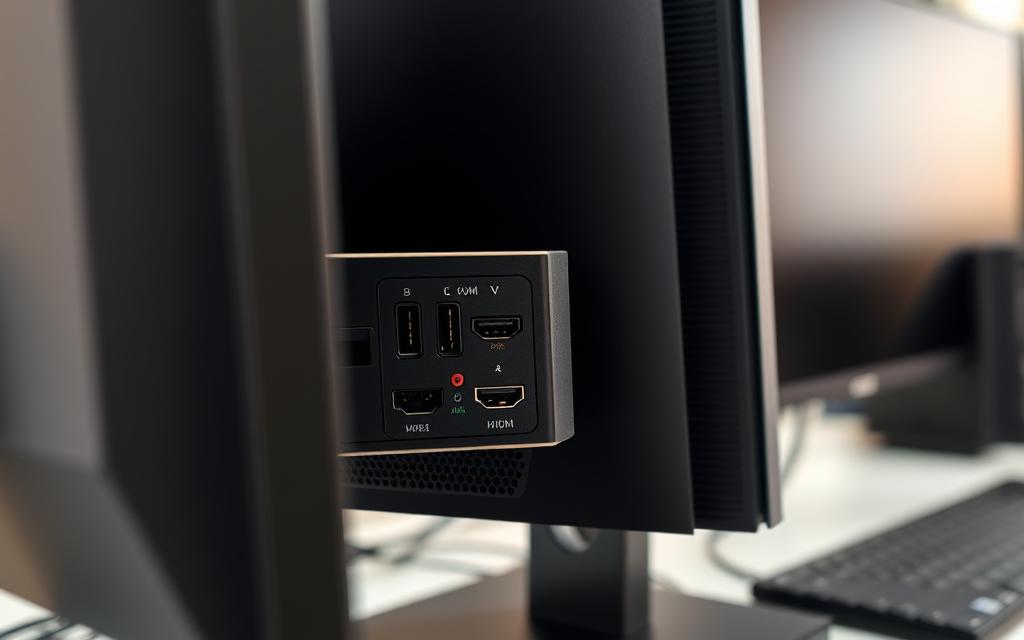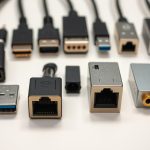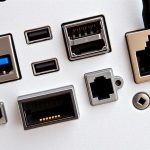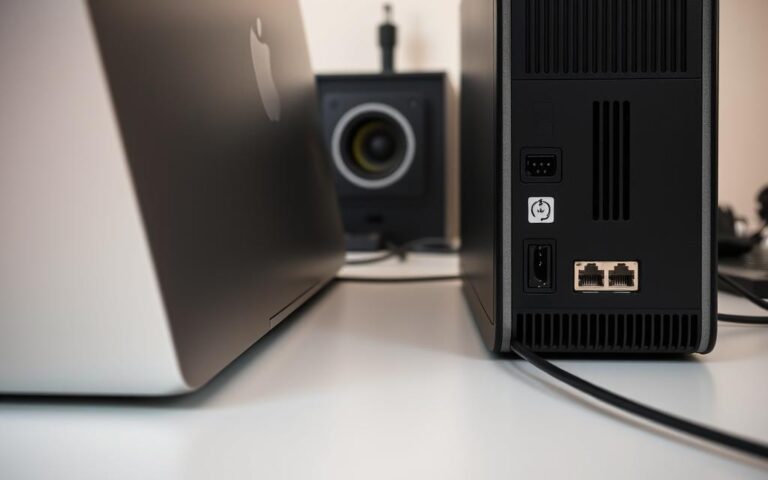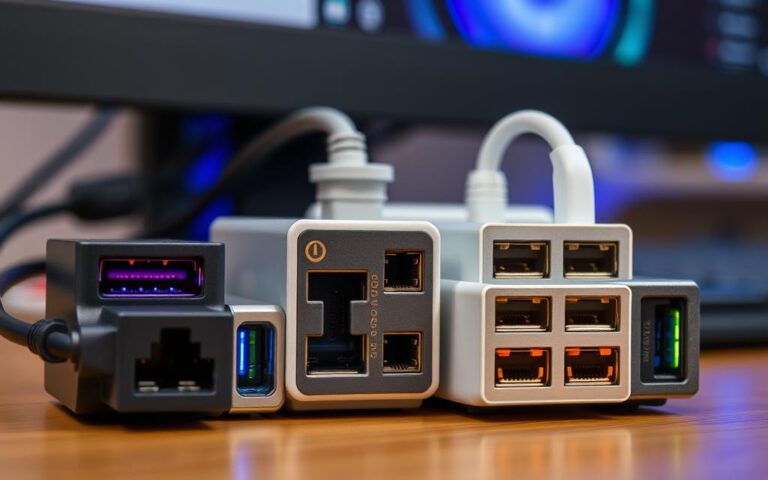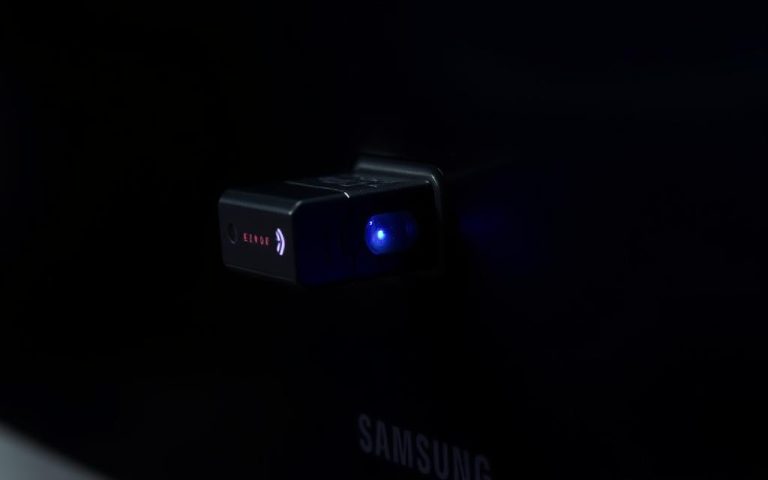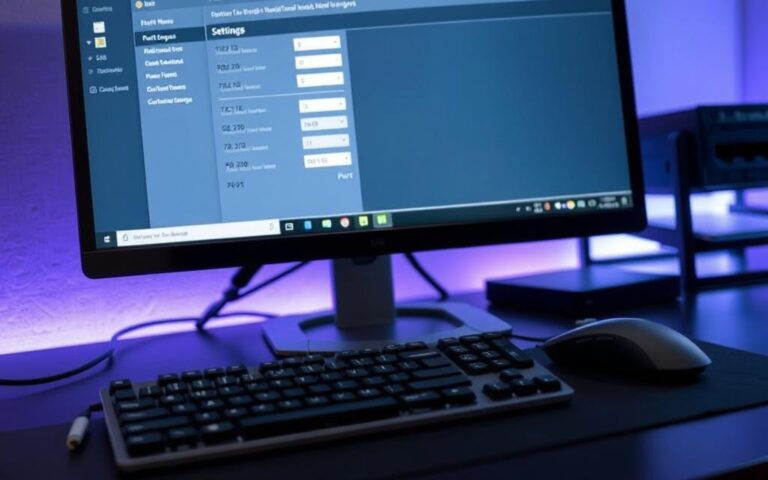HDMI Port Availability on Computer Monitors
More and more computer monitors now include HDMI ports. This fact greatly improves how monitors connect to different devices. Because HDMI (High Definition Multimedia Interface) is the go-to for high-definition multimedia sharing, it’s become key in new display tech. This piece looks at how common HDMI ports are in monitors. It also taps into the enthusiasm of users eager to use the newest HDMI cables for their systems.
Understanding HDMI Ports
The HDMI definition stands for High Definition Multimedia Interface. It’s a key technology for sending top-quality audio and video signals. This tech is vital in many devices, making modern multimedia smooth and enjoyable. The history of HDMI shows its growth and big effect on consumer electronics.
What is HDMI?
HDMI is a versatile connection that sends both audio and video from gadgets to screens. It lets a single cable carry high-def video and multi-channel audio. Thanks to its ease, HDMI is the top choice for connecting TVs, computers, and other gear.
History of HDMI Technology
The HDMI journey started in 2003 with the launch of HDMI 1.0. It was a big step forward from older tech. Now, we have HDMI 2.1, which supports even better quality video. It allows 4K video at 120 fps and 8K at 60 fps. This shows HDMI’s ongoing progress in improving video tech.
Different Types of HDMI Cables
There are different HDMI cables for various needs. HDMI Standard is good for 1080p resolution. HDMI High Speed is for 4K content. For HDR, there’s HDMI Premium High Speed, and HDMI Ultra High Speed is for 8K video. Knowing these types helps use HDMI tech to its fullest.
| Cable Type | Resolution | Features |
|---|---|---|
| HDMI Standard | Up to 1080p | Basic audio and video support |
| HDMI High Speed | Up to 4K | Supports higher refresh rates |
| HDMI Premium High Speed | HDR | Enhanced video quality |
| HDMI Ultra High Speed | Up to 8K | High bandwidth for advanced applications |
As tech moves forward, knowing HDMI and what it can do is key. This is especially true when picking connection options for devices. For a deeper look at video ports, check this resource.
Do Computer Monitors Have HDMI Ports?
HDMI ports are now common in computer monitors. This change shows they are a key part of modern display connections. People find them very useful for various reasons.
Common Monitors with HDMI Ports
Nowadays, most computer monitors come with HDMI ports. You can find them in common monitor types, from affordable options to luxurious ones. Big brands like Dell, LG, and Samsung include HDMI ports in almost all their latest models. This makes it easy for buyers to find the right monitor for their needs.
Benefits of HDMI Ports in Monitors
HDMI ports in monitors bring many HDMI advantages. They make it easy to connect to different devices, like gaming consoles, PCs, and media players. With just one cable, users can experience high-quality sound and video. Plus, HDMI supports cool features like 3D and 4K resolutions, making entertainment even better. This makes HDMI ports a top choice for people who want both variety and high quality in their setups.
| Monitor Type | HDMI Support | Price Range |
|---|---|---|
| Budget Monitors | Yes | $100 – $300 |
| Mid-Range Monitors | Yes | $300 – $700 |
| High-End Monitors | Yes | $700 and above |
Alternative Monitor Ports
HDMI is often chosen for monitor connections but there are other options. DVI, DisplayPort, and VGA are also used. Knowing about these can help you pick the right monitor.
DVI: A Legacy Connector
DVI, or Digital Visual Interface, improved on the older VGA. It supports high resolutions, up to 2560×1600 pixels. Many desktops and monitors still have this legacy connector. However, DVI does not carry audio, which means you need a separate cable for sound.
DisplayPort: The Growing Competitor
DisplayPort came out in 2008 and has become popular with high-end monitors. It supports both high resolutions and audio. Its unique feature is allowing multiple monitors to connect through one port. DisplayPort is becoming more important in monitor technology.
VGA: The Old Standard
VGA has been around since 1987 but is becoming less common. It used to be the go-to for monitor connections. However, its resolution capabilities are lower than those of DVI and DisplayPort. As tech moves forward, VGA is harder to find in new devices.
| Connector | Year Introduced | Max Resolution | Audio Support | Usage |
|---|---|---|---|---|
| DVI | Mid-2000s | 2560×1600 | No | Desktops, LCD Monitors |
| DisplayPort | 2008 | Varies; supports very high resolutions | Yes | Premium Monitors, Multi-Monitor Setups |
| VGA | 1987 | Limited | No | Legacy Devices |
The Evolution of Monitor Connectivity
Monitor technology has changed a lot from the early days of analog to today’s digital screens. Every step forward in this journey has made our screens perform better and feel nicer to use. Going digital has changed the way our screens talk to computers and gadgets, making things clearer for both everyday users and experts.
From Analog to Digital
The big change from analog to digital was a key moment for screen tech. Old monitors used VGA and sent out analog signals. This meant the pictures weren’t as sharp. But in the mid-2000s, we moved to LCDs which were lighter and saved more energy. By the 2010s, LED backlighting in LCD monitors became the norm, showing the shift towards better quality with digital ways.
Current Standards and Trends
Nowadays, monitors mainly use HDMI and DisplayPort. They are great because they can show very clear pictures and even handle High Dynamic Range (HDR). HDMI became more popular as people watched more digital entertainment. By 2021, about 10 billion devices had HDMI. USB-C started in 2014 and it’s good because it can do a lot. It can handle data, show video, and even power devices. These new digital options make setting up easier and show how screen connections keep getting better.
| Connectivity Type | Resolution Support | Year Introduced | Typical Use Case |
|---|---|---|---|
| VGA | Up to 1920 x 1200 | 1987 | Legacy devices |
| DVI | Up to 2560 x 1600 | 1999 | PCs and monitors |
| HDMI | Up to 8K | 2003 | Consumer electronics |
| DisplayPort | Up to 8K | 2006 | High-end monitors |
| USB-C | Variable | 2014 | Laptops and mobile devices |
Key Advantages of HDMI Over Other Ports
HDMI has changed how we connect audio and video devices for the better. It offers many benefits that make it the top choice for a lot of people. When you understand these benefits, you see why HDMI is so popular in multimedia.
Audio and Video Transmission
HDMI’s key strength is its ability to carry both sound and picture in one cable. This simplifies setting up your devices and cuts down on messy wires. It works well with many devices, making everything run smoothly whether at home or work.
Support for 4K and 3D Formats
HDMI leads the way in supporting high-def content like 4K support and 3D. As more high-quality content comes out, it’s important to have devices that can show it properly. HDMI 2.1 goes even further, with better speed to bring you amazing visuals and sound for games and movies.
Device Versatility
HDMI is known for its great multi-device compatibility. You can find HDMI ports on TVs, games consoles, projectors, and laptops. This means you can connect many different devices easily for a smooth experience. It allows for complex setups without needing lots of adapters, making your entertainment system more connected.
For deeper understanding of HDMI compared to other standards, check out this detailed analysis. It explains the differences between HDMI and DisplayPort in more detail.
How to Check HDMI Availability on Monitors
Finding out if your monitor has HDMI is key for easy connection. Start by looking for HDMI ports on your monitor’s back and sides. They have a special shape. Knowing about HDMI helps solve any issues that might come up.
Identifying HDMI Ports on Monitors
Check your monitor’s back and sides to spot HDMI ports. They look trapezoidal, setting them apart from other connections. To be sure, look up your monitor’s details online. Today, monitors usually have at least one HDMI port, making them work well with many devices.
Common User Issues and Solutions
Sometimes, when connecting devices, users face HDMI problems. These might be due to using older devices or not setting up things right. Some common fixes include:
- Using HDMI to DVI or USB-C to HDMI adapters for better compatibility.
- Making sure the HDMI cable is firmly connected at both ends.
- Choosing the correct input on the monitor for the device you’ve connected.
Each of these solutions helps fix connection issues, ensuring a better HDMI experience.
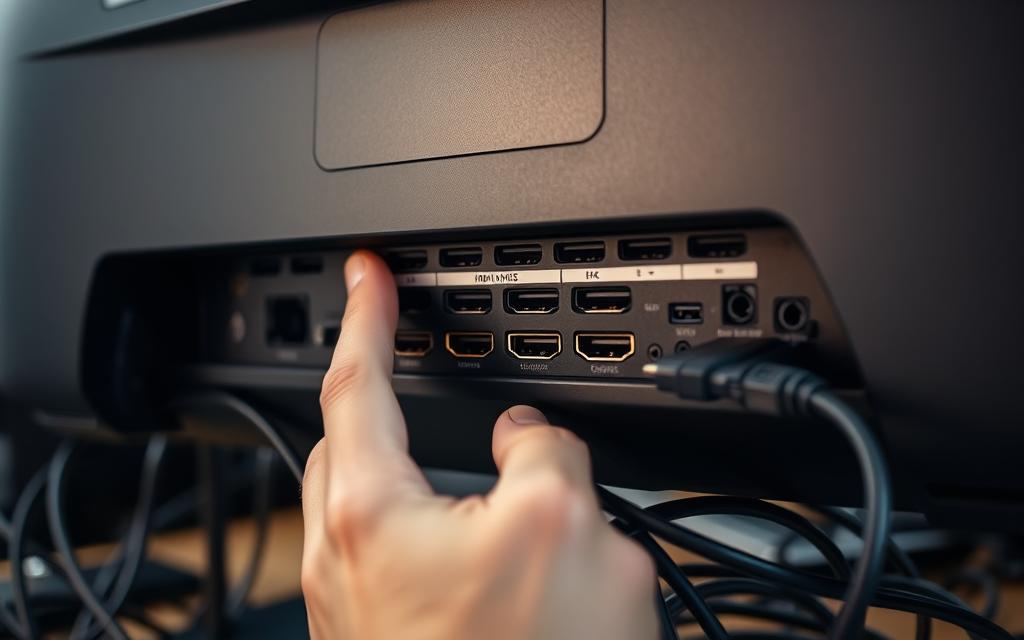
| Issue | Possible Cause | Solution |
|---|---|---|
| No Display | Loose HDMI Connection | Check and secure both ends of the HDMI cable. |
| Poor Picture Quality | Incompatible Cable | Replace with high-quality HDMI cable suitable for the resolution. |
| No Audio | Incorrect Audio Output Settings | Adjust audio output settings on the computer to HDMI. |
| Device Not Recognised | Outdated Driver | Update the graphics card drivers on your computer. |
Future of HDMI in Computer Monitors
The future of HDMI technology looks bright, bringing big improvements for computer monitors. These updates are designed to meet the growing need for better resolutions and quicker refresh rates. They aim to boost monitor performance for both gaming and multimedia uses.
New Developments in HDMI Technology
HDMI 2.1 is a game-changer, offering support for up to 10K resolution. It comes with features like Variable Refresh Rate (VRR), important for gaming consoles such as PlayStation 5 and Xbox Series X/S. With HDMI 2.0 phased out, HDMI 2.1 now includes all its features, keeping it at the forefront of technology.
The cost of HDMI 2.1 monitors, like the Gigabyte Aorus FI32U and Acer Nitro XV282K KV, is still around $1,000. This reflects their advanced technology and capabilities.
Pioneering Applications of HDMI in Monitors
The use of HDMI in monitors is set to grow significantly. The demand for high-bandwidth connections is rising in setups with multiple monitors and virtual reality. Even though HDMI 2.1 shines in gaming, DisplayPort might still lead for general computing needs.
Yet, HDMI’s compatibility with gaming consoles means it will keep evolving. This ensures HDMI will continue to meet the changing needs of users.
Conclusion
HDMI plays a key role in connecting monitors and laptops. Its unique design lets you send video and audio through one cable. This makes setting up your display easier.
It’s important for buyers to understand HDMI as technology changes. HDMI remains a top choice, evolving to handle better resolutions and more uses. Innovations like HDMI 2.1 and USB-C with DisplayPort Alt Mode bring more flexibility and benefits for everyday use and gaming.
Keeping up with HDMI technology improvements helps users make smart choices. As HDMI becomes more common in monitors alongside other connections, staying informed lets you get the most out of modern displays.
FAQ
What does HDMI stand for?
HDMI means High Definition Multimedia Interface. It allows audio and video to be sent together.
Are all computer monitors equipped with HDMI ports?
Many new computer monitors have HDMI ports. This makes it easy to connect different devices.
What types of HDMI cables are available?
You can find several HDMI cables. There’s HDMI Standard for 1080p and HDMI High Speed for 4K. Also, HDMI Premium High Speed for HDR, and HDMI Ultra High Speed for 8K video.
How can I identify HDMI ports on a monitor?
Look at the back and sides of the monitor for the HDMI port’s unique shape. You can also check the monitor’s specs online.
What are the advantages of using HDMI ports?
HDMI ports make it easy by using one cable for audio and video. They support high-res content and features like 3D and 4K.
What is the difference between HDMI and DisplayPort?
HDMI and DisplayPort both handle high resolutions and audio. But DisplayPort can link many monitors from one port. It’s great for complex setups.
Why is HDMI preferred over older standards like VGA?
HDMI is better because it sends digital audio and video. It supports higher resolutions without losing quality, unlike VGA.
What common issues do users face with HDMI connections?
Some issues include connectivity problems and not working with old devices. Using adapters like HDMI to DVI or USB-C to HDMI can help.
What developments can we expect in future HDMI technology?
Future HDMI will aim for even better resolutions and refresh rates. HDMI 2.1 will handle up to 10K resolution, improving gaming and video production.

